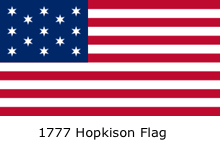 History
History
 Flags of the United States
Contact
Flags of the United States
Contact
Don's Home
 History
History
 Flags of the United States
Contact
Flags of the United States
Contact
|
Early flags of the United States: .png)  The Hopkinson flag is generally believed to be the first. Hopkinson was a delegate to the Continental Congress from New Jersey and a signer of the Declaration of Independence. The 6-pointed stars come from Hopkinson's coat of arms from England. Washington's coat of arms also had 6-pointed stars. The so-called Betsy Ross flag was more likely a flag used for celebrations of anniversaries of the nation's birthday. Her descendants claimed it was the first flag, but there is no evidence of that. The first documented usage of this flag was in 1792. See Betsy Ross flag.
In 1795, the number of stars and stripes was increased from 13 to 15 (to reflect the entry of Vermont and Kentucky as states of the Union). For a time the flag was not changed when subsequent states were admitted, probably because it was thought that this would cause too much clutter.
|